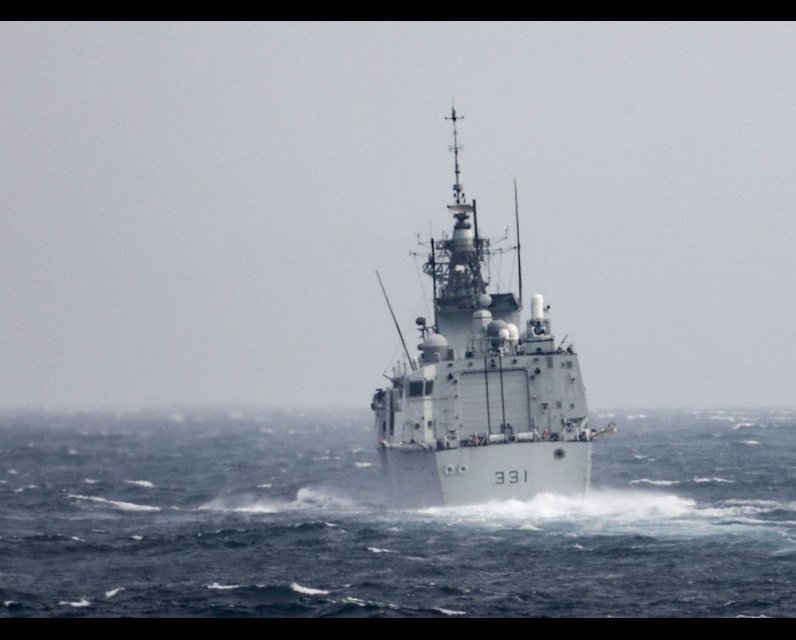Source Feed: National Post
Author: Chris Lambie
Publication Date: April 30, 2025 - 07:00
Mould found in nearly half the Royal Canadian Navy's frigates
April 30, 2025

Mould has been discovered in nearly half of the Royal Canadian Navy’s 12 frigates.
Cheryl Forrest, who speaks for National Defence, confirmed that mould has been found in five frigates, the most recent on HMCS Vancouver this year.
“Small amounts of mould have been reported in two areas of high humidity on HMCS Vancouver recently and were quickly removed and the areas cleaned,” Forrest said in an email. “This also resulted in enhanced inspections of similar areas of concern on the ship with no other mould areas reported.”
The other contaminated ships are HMCS St. John’s in 2011, HMCS Calgary in 2018, HMCS Halifax and HMCS Charlottetown in 2019.
While Forrest didn’t mention it, a report from the Directorate of Force Health Protection released in 2018 indicates an air quality assessment aboard HMCS Winnipeg found higher-than-normal levels of mould spores in three compartments while the frigate was sailing from Tokyo to Hawaii in July 2017.
The mould was removed from “affected frigates,” Forrest said. “Technical enhancements were completed to improve air quality. If mould recurs, ships have been directed to clean and report it immediately.”
Maritime and shipboard environments can be humid and warm, which makes them naturally prone to mould, she said.
The issue of mould in the Halifax-class warships made headlines recently when a Federal Court judge shot down a proposed class action case led by a former Royal Canadian Air Force captain who claimed “dangerous levels of toxic mould” in HMCS Vancouver caused him serious ongoing health problems. The judge ruled Félix Dunn, an air combat systems officer who was stationed aboard the warship from June until December of 2016, couldn’t sue the federal government over the mould issue because Veterans Affairs Canada had already compensated him for the same injury.
Forrest said the military has developed an air quality program for the frigates “to support a safe working environment.”
“This involves the Canadian Forces Deployable Health Hazard Assessment Team onboard a Halifax Class frigate each year for a period of two weeks to undertake an indoor air quality assessment throughout the ship. Collected samples are tested by an independent laboratory to determine if mould spores are present in a greater quantity than a sample of outdoor air reference sample.”
HMCS Ville de Quebec “was surveyed (last October) and no significant mould issues were identified,” Forrest said. “HMCS Vancouver has been selected to have this survey undertaken during 2025.”
Inspection and cleaning routines for the ventilation trunking, or ductwork in the frigates, happens on a five-year schedule, she said. “Areas which are prone to high humidity (such as places where food is served and prepared, and washrooms) are inspected and cleaned more frequently (on a 12-month or a 24-month schedule).”
Preventative medicine experts from Canadian Forces Health Services also conduct a visual sanitation certification every six months on the ships, with air quality inspections conducted on a three-year cycle.
When National Post asked if people are reporting illness due to the mould in the frigates, Forrest said, “a review of records for the last 36 months revealed no mould-related symptoms having been reported to our Preventative Medicine Offices.”
But Ken Hansen, a defence analyst and former navy commander, said reporting health problems due to mould could hurt a sailor’s career.
“You’d probably be posted ashore as unfit for sea duty,” Hansen said.
“So, there’s a money penalty there. Plus, everybody is training with an eye to getting promoted and moved up, or getting on to a career course, both of which you would be prohibited from doing… If you’re ill, there will be a restriction on your employment, which means the career manager will pull your file out of the stack that’s going in to the (annual selection) board. So, there’s another penalty.”
When a sailor’s identified as unfit for sea duty, they go on a period of two years of accommodation, he said. “Literally it’s a stopwatch that’s counting down to your last day in the service, and there’s huge pension and income implications for that.”
Many choose not to complain about various ailments for fear of torpedoing their careers, according to Hansen. “There are a lot of guys walking around who are hurting and they are not telling anybody.”
The navy has made technical changes to combat mould in the frigates, including drainage modifications in the primary air conditioning systems, fleet-wide air conditioning control system upgrades, and primary air rebalancing trials, Forrest said.
“Strict mould cleaning procedures are in place for our frigates,” she said. “Training and direction are regularly provided on the importance of ships’ cleaning to maintain shipboard air quality.”
Richard Shimooka, senior fellow with the Macdonald-Laurier Institute, wasn’t surprised to hear mould has been detected in nearly half the navy’s frigates, the first of which, HMCS Halifax, launched in 1988 and went into service in 1992.
“Each one now takes a million dock work hours to get up and running for a deployment,” Shimooka said. “It used to take 100,000. Now it’s up to a million and it’s going to go higher.”
The frigates have operated in hot climates, such as the Indian Ocean, he said. “There’s a lot of accumulated time on these vessels and they’ve been worked hard.”
Our website is the place for the latest breaking news, exclusive scoops, longreads and provocative commentary. Please bookmark nationalpost.com and sign up for our daily newsletter, Posted, here.
Last-minute changes on a $100-million purchase of night-vision equipment for the Canadian Army have excluded European firms and now favours U.S. manufacturers, defence company representatives say. Read More
April 30, 2025 - 11:00 | David Pugliese, Ottawa Citizen | Ottawa Citizen
During World War II, the United States was desperate to develop the nuclear bomb ahead of Germany and maintain a technological advantage. To do so, they needed to produce plutonium, and lots of it. They would produce that plutonium at a site in Hanford, Washington, due to its proximity to the Columbia River and its distance from people, given the concern over an accidental explosion. The plutonium manufactured there would be used in the first nuclear bomb ever detonated. Over the following forty years, the site would produce two-thirds of the plutonium in the US nuclear arsenal.
As...
April 30, 2025 - 10:53 | Filipa Pajevic | Walrus
Canada’s federal bureaucrats are likely breathing a sigh of relief, at least for the time being, not just for their jobs but for the largely recognizable landscape they can expect to face in the immediate future. What’s less certain is whether the Mark Carney government’s modest commitments to efficiency and improved productivity will provide the strong medicine Canada’s public sector really needs. Read More
April 30, 2025 - 10:43 | Christina Spencer, Ottawa Citizen | Ottawa Citizen




Comments
Be the first to comment